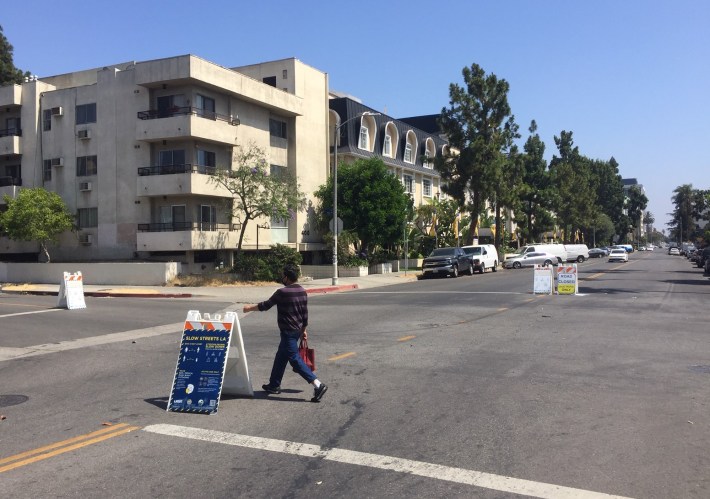
It took an advocacy campaign, a false start, and a while to get going, but the L.A. City Transportation Department (LADOT) has been implementing Slow Streets. This program grew out of a need to provide quick-build safe spaces for people to distance while walking and bicycling during COVID-19 stay-at-home orders - at a time when reduced traffic was resulting in drivers speeding and killing people.
KPCCs Ryan Fonseca tweeted that LADOT has installed Slow Streets in nine L.A. neighborhoods: Del Rey, Sawtelle, Mid-City West, Eagle Rock, Destination Pico, Koreatown, Watts, South L.A., and North Hollywood. Fonseca's Twitter thread includes maps and more information on how the Slow Streets program is going.
Social media includes quite a few happy photos of Angelenos - including many families with young children (who, trust me, are a handful during stay-at-home) - enjoying these Slow Streets.
Mid City kids using their #slowstreets like pros 👌 pic.twitter.com/5CmJT3vfgZ
— Julia Campbell (@PlangineerJulia) May 26, 2020
Plus a few photos showing some issues with entitled drivers reluctant to peacefully share space with fellow humans.
Driver in gold sedan honked and shouted “not a bike zone, I called the city about this!” before forcing their way through. The success of Slow Streets shouldn’t be measured by angry, misinformed people that call the city but instead by the happy families using the street. pic.twitter.com/alo8nMPVw8
— Walk Eagle Rock (@walkeaglerock) June 17, 2020
Yesterday, I took a spin down my nearest Slow Street: 4th Street in Koreatown.
Fourth has long been a city designated bike route and a rare relatively quiet east-west corridor through central Los Angeles. For decades it has been well used by cyclists, and a fair amount of people walking and running. LADOT installed sharrows there in 2010, but twice now pushes for minimal prioritization of walking/bicycling have failed when city councilmembers couldn't support implementing anything that might prevent cut-through car traffic, remove car parking, or otherwise marginally inconvenience car drivers.
I, my daughter, my partner, and other families living at L.A. Eco-Village have been bicycling on 4th Street quite a bit under COVID-19. With relatively little traffic during stay-at-home, the quieter parts of 4th Street supported plenty of people out safely walking, bicycling, and jogging. Sidewalks were sometimes crowded, so pedestrians and runners were often in the street with cyclists and an occasional driver.

A couple of weeks ago, LADOT implemented a Slow Street on 4th Street; this now consists of sandwich boards from New Hampshire Avenue to Hobart Boulevard in Koreatown. The sandwich boards have signs that say "ROAD CLOSED - LOCAL TRAFFIC ONLY" and "ATTENTION DRIVERS: THIS IS A SLOW STREET." The signs are in English only, despite lots of Spanish-, Korean-, and Bengali-speaking residents living along this part of 4th.
Yesterday afternoon on Fourth, I saw some pedestrians on sidewalks, a few individual cyclists, no families in the street, and quite a bit of car traffic.

A half dozen of the sandwich boards had fallen down, probably hit by drivers. The boards and signs sat unused on nearby sidewalks.
I observed some drivers going a bit slower, but, by and large, they have figured out that they can pretty much ignore the signs, and continue to cut through the "local traffic only" blocks with impunity. With L.A. relaxing COVID restrictions, there's plenty of car traffic on 4th Street again.
At least for 4th Street, it seems like a full-on bike boulevard treatment is needed - like is done in civilized countries including Oakland, San Luis Obispo, etc. Don't just put up a sign, but actually close a couple of entry points so drivers really can't cut through. These streets would not be closed to cars, but in some cases drivers would go a few blocks out of their way.
Readers - how are Slow Streets working in the rest of the city? What works? What doesn't? Any interesting do-it-yourself improvements helping? Share your thoughts in the comments below.







